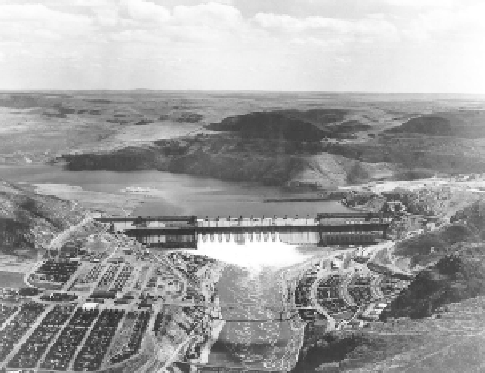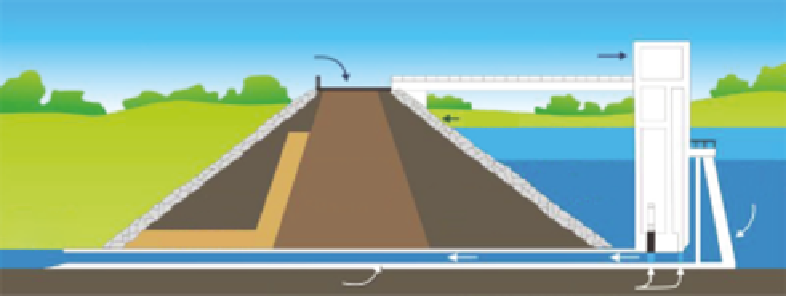Environmental Engineering Reference
In-Depth Information
FIGURE 10.9
Aerial view of the partially completed Grand Coulee Dam taken on June 15, 1941. (Courtesy
of the U.S. Bureau of Reclamation.)
10.3.2 f
ILL
d
aMS
Fill dams depend on the frictional resistance of materials and mass to resist the forces acting
on them. Examples include earth ill, rock ill, hydraulic ill, and levees. Typically, ill dams are
made entirely of an impervious material (are homogeneous) or they are layered or zoned with a
waterproof core, such as clay, protected by a ilter and drain. The core is then covered with earth
or rock ill. While the core materials may not be completely impervious to water, they provide
suficient control of seepage, along with the ilter and drain to remove excess water, as illustrated
in Figure 10.10. One common type of dam is the concrete-faced, rock-ill dam, which is con-
structed of permeable rock ill, the impermeable membrane being a concrete slab constructed on
the upstream face of the dam wall.
As with gravity dams, ill dams rely only on their weight and friction to resist the forces acting on
them. Depending on the availability of materials, earth-ill dams are the least expensive to build and
are the most common dam type (Figure 10.8). An example is Fishtrap Dam in Kentucky, illustrated
in Figure 10.11.
Roadway
Intake tower
Riprap
Flood control pool
Compacted
clay core
Water
intake
Multipurpose
pool
Compacted
earth
Sand drain
Compacted
earth
Stilling
basin
Tunnel
Water control gates
FIGURE 10.10
Structure and outlet works of Melvern Lake, Kansas; a rolled earth-ill structure with an
emergency uncontrolled chute spillway and outlet works consisting of a single horseshoe conduit and two
hydraulically operated gates. (Courtesy of the U.S. Army Corps of Engineers, Kansas City District.)


Search WWH ::

Custom Search